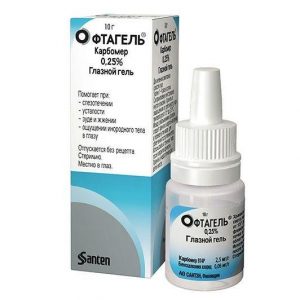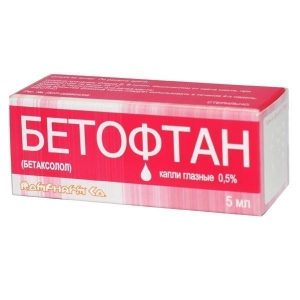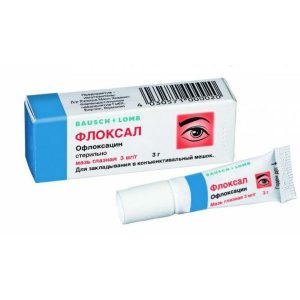Description
Pharmacological action
Levofloxacin is the L-isomer of the racemic drug substance ofloxacin.
The antibacterial activity of ofloxacin refers mainly to the L-isomer. As an antibacterial drug of the fluoroquinolone class, levofloxacin blocks DNA gyrase (topoisomerase II) and topoisomerase IV, disrupts the supercoiling and cross-linking of DNA breaks (deoxyribonucleic acid), inhibits DNA synthesis, causes deep morphological changes in the cytoplasm, cell wall and membranes.
Mechanism for the development of resistance
Resistance to levofloxacin can develop, first of all, according to two main mechanisms, namely: a decrease in the intracellular concentration of the drug or changes in the target action of the drug.
Changes in targets, two bacterial enzymes of DNA gyrase and topoisomerase IV, result from mutations in the chromosomal genes encoding DNA gyrase (gyrA and gyrB) and topoisomerase IV (rarC and parE grlA and grlB in Staphylococcus aureus).
The stability of the drug due to low intracellular concentration develops as a result of a change in the porin channel system of the outer membrane of the cell, which leads to a decrease in fluoroquinolone intake in gram-negative bacteria, or from efflux pumps. Efflux-mediated resistance has been described with respect to pneumococci (PmrA), staphylococci (NorA), anaerobic and gram-negative bacteria.
Plasmid-mediated resistance to quinolones (determined based on the qnr gene) was detected against Klebsiella pneumoniae and Escherichia coli.
Possible development of cross-resistance between fluoroquinolones. Single mutations may not lead to clinical resistance, but multiple mutations cause clinical resistance to all drugs in the fluoroquinolone class. Subjected to changes in the porins of the outer membranes and the efflux system can have broad substrate specificity, affecting several classes of antibacterial agents and leading to multiple resistance.
For the majority ( 90%) of strains of the following microorganisms in vitro, the minimum inhibitory concentrations of levofloxacin (2 Ñg / ml or less) were established, however, the effectiveness and safety of the clinical use of levofloxacin in the treatment of infections caused by these pathogens has not been established in adequate and well-controlled studies: gram-positive aerobes – Staphylococcus haemolyticus, Streptococcus (group C / F), Streptococcus (group G), Streptococcus agalactiae, Streptococcus milleri. Streptococcus viridans Gram-negative aerobes – Acinetobacter lwoffii, Acinetobacter baumannii, Bordetella pertussis, Citrobacter (diversus) koseri, Citrobacter freundii, Enterobacter aerogenes, Enterobacter sagazakii, Klebsiella oergeromegioergomegeromegioergomegeromegioergomegeromegioergomegeromegioergomegeromegomegor Providencia stuartii, Pseudomonas fluorescens gram-positive anaerobes – Clostridium perfringens.
Sensitive microorganisms:
aerobic gram-positive microorganisms – Corynebacterium diphtheriae, Enterococcus spp., including Enterococcus faecalis, Listeria monocytogenes, Staphylococcus spp. (coagulase-negative methicillin-sensitive / leukotoxin-containing / moderately sensitive strains), including Staphylococcus aureus (methicillin-sensitive strains), Staphylococcus epidermidis (methicillin-sensitive strains), Streptococcus spp. groups C and G, Streptococcus agalactiae, Streptococcus pneumoniae (penicillin-sensitive / moderately sensitive / resistant strains), Streptococcus pyogenes, Streptococcus spp. viridans groups (penicillin-sensitive / resistant strains)
aerobic gram-negative microorganisms – Acinetobacter spp., including Acinetobacter baumannii, Acinetobacillus actinomycetecomitans, Citrobacter freundii, Eikenella corrodens enteroberogen, enterobacterobobacterobentoberobentoberobacterobacterobacterobacterobacterobacterome Escherichia coli, Gardnerella vaginalis, Haemophilus ducreyi, Haemophilus influenzae (ampicillin-sensitive / resistant strains), Haemophilus parainfluenzae, Helicobacter pylori, Klebsiella spp. , Morganella morganii, Neisseria gonorrhoeae (producing and non-producing enitsillinazu strains), Neisseria meningitidis, Pasteurella spp., including Pasteurella canis, Pasteurella dagmatis, Pasteurella multocida, Proteus vulgaris, Providencia spp., including Providencia rettgeri, Providencia stuartii, Pseudomonas spp., including Pseudomonas aeruginosa, Serratia spp., including Serppia salmonella .
anaerobic microorganisms – Bacteroides fragilis, Bifidobacterium spp., Clostridium perfringens, Fusobacterium spp., Peptostreptococcus spp., Propionibacterium spp., Veilonella spp.
other microorganisms – Bartonella spp., Chlamydia pneumoniae, Chlamydia psittaci, Chlamydia trachomatis, Legionella pneumophila, Legionella spp., Mycobacterium leprae, Mycobacterium tuberculosis, Mycoplasma hominis, Myeoplasma Rickettsia spp., Ureaplasma urealyticum.
Moderately susceptible microorganisms (BMD> 4 mg / l):
aerobic gram-positive microorganisms – Corynebacterium urealyticum, Corynebacterium xerosis, Enterococcus faecium. Staphylococcus epidermidis (methicillin-resistant strains), Staphylococcus haemolyticus (methicillin-resistant strains)
aerobic microorganisms gramotritsatelnye – Burkhoideria cepacia, Campylobacter jejuni, Campylobacter coli, anaerobic microorganisms – Bacteroides thetaiotaomicron, Bacteroides vulgatus, Bacteroides ovatus, Prevotella spp, Porphyromonas spp..
Resistant microorganisms (BMD more than 8 mg / ml):
aerobic gram-positive microorganisms – Corynebacterium jeikeium, Staphylococcus aureus (methicillin-resistant strains), other Staphylococcus spp. (coagulase-negative methicillin-resistant strains)
aerobic gram-negative microorganisms – Alcaligenes xylosoxidane other microorganisms – Mycobacterium avium.
Minimum inhibitory concentrations of levofloxacin for certain microorganisms
Microorganism
Sensitive, mg / ml
Resistant, mg / ml
Pseudomonas spp.
1
> 2
Staphylococcus spp.
1
> 2
Streptococcus
1
> 2
Streptococcus pneumoniae
1
> 2
Haemophilus influenzae
1 srdlkr higher than for ofloxacin against representatives of Enterobacteriaceae, Pseudomonas aeruginosa and gram-positive microorganisms.
In the case of levofloxacin in the treatment of chlamydial diseases of the organs of vision, concomitant therapy is required.
The degree of sensitivity of microorganisms to levofloxacin can have significant geographical differences.
The maximum concentration of levofloxacin achieved with eye drops of 0.5% is more than 100 times the minimum inhibitory concentration (MIC) of levofloxacin for sensitive microorganisms.
Indications
– Treatment of superficial bacterial infections of the eye caused by susceptible microorganisms in adults and children older than 1 year.
– Prevention of complications after surgical and laser operations on the eye.
Contraindications
Hypersensitivity to levofloxacin or to any of the components of the drug, as well as to other quinolones.
Caution:
Childhood.
Use during pregnancy and lactation
Pregnancy
There is insufficient data on the use of levofloxacin in pregnant women. The results of preclinical studies do not indicate a direct or indirect adverse effect with respect to toxic effects on reproductive function and intrauterine development. The potential risk of the drug to humans is unknown.
Levofloxacin eye drops can be used during pregnancy if the potential benefit to the mother outweighs the potential risk to the fetus.
Breastfeeding period
Levofloxacin passes into breast milk. However, when using levofloxacin in therapeutic doses, effects on the infant are not expected.
Levofloxacin eye drops can be used during breastfeeding if the potential benefit to the mother outweighs any possible risk to the infant.
Fertility
After topical administration, levofloxacin did not cause a deterioration in fertility in rats when exposed to significantly higher than the maximum human dose.
Special instructions
The drug cannot be administered subconjunctivally and into the anterior chamber of the eye.
The drug should not be used while wearing hydrophilic (soft) contact lenses due to the presence of benzalkonium chloride preservative in it, which can be absorbed by contact lenses and have an adverse effect on eye tissue, as well as cause discoloration of contact lenses.
To avoid contamination of the dropper tip and solution, do not touch the eyelids and tissues around the eyes when instilling.
With prolonged treatment with levofloxacin (like other antibiotics), excessive growth of insensitive microorganisms, including fungal flora, is possible.
If the disease worsens or there is no improvement with levofloxacin, it is necessary to cancel therapy with levofloxacin and switch to therapy with antibacterial drugs of other groups, with an extended ophthalmological examination, including biomicroscopy and a fluorescein test.
Information on the efficacy and safety of levofloxacin in the treatment of corneal ulcers is not available.
No clinical formation of corneal precipitates has been reported in clinical studies.
Impact on the ability to drive transp. Wed and fur .:
The drug does not have a significant effect on the ability to drive vehicles, mechanisms. Immediately after instillation, temporary blurring of vision is possible. It is not recommended to drive vehicles and engage in other potentially hazardous activities, requiring increased concentration of attention and speed of psychomotor reactions, until restoration of the clarity of visual perception.
Dosage and Administration
Locally, in the affected eye.
The duration of treatment is determined by the severity of the condition, its clinical and bacteriological characteristics. The average duration of a course of therapy is 5 days.
1-2 drops in the affected eye (a) every two hours up to 8 times a day during wakefulness for the first 2 days, then 4 times a day from 3 to 5 days.
When using several drugs, the interval between their instillations should be at least 15 minutes.
Side effects
The incidence of adverse reactions during levofloxacin therapy was about 10%. Most often, the severity of adverse reactions ranged from mild to moderate severity, adverse reactions were noted mainly from the side of the organ of vision. Information about adverse events was obtained during clinical trials and post-registration use.
Immune System Disorders:
Rarely (> 1/10000, < 1/1000): systemic allergic reactions, including skin rash. Very rare (<1/10000): anaphylactic shock. Disorders of the nervous system: Infrequently (> 1/1000, <1/100): headache. Disorders of the organ of vision: Often (> 1/100, <1/10): burning in the eye, decreased vision, filamentous mucous discharge in the conjunctival cavity. Infrequently (> 1/1000, <1/100): chemosis, conjunctival injection, papillary conjunctivitis, edema of the eyelids, erythema of the eyelids, discomfort in the eye, itching in the eye, pain in the eye, dry eye syndrome, photophobia. Disorders of the respiratory system, chest and mediastinum: Infrequently (> 1/1000, <1/100): rhinitis. Very rare (<1/10000): laryngeal edema. The profile of adverse events with the use of the drug in the pediatric population is comparable to the adult population. Drug Interactions No specific drug interaction studies have been performed. Since the maximum concentration of levofloxacin in plasma after topical application in the eye is at least 1000 times lower, than after taking standard doses by mouth, interaction with other drugs characteristic of systemic use is most likely clinically insignificant. Overdose The total amount of levofloxacin contained in one bottle of eye drops is too small to cause toxic reactions even after accidental ingestion. After topical application of an excessive dose of the drug, the eyes should be washed with clean (tap) water at room temperature. Storage conditions Store at a temperature not exceeding 25 ° C. Keep out of the reach of children. The Expiration of is 3 years. Deystvuyuschee substances Levofloxacin Form of Treatment rims glazn e




